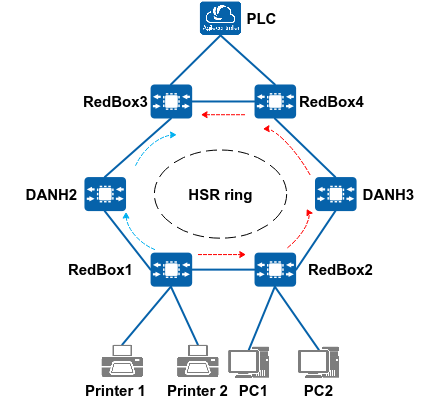What Is HSR?
As a protocol for highly reliable industrial network transmission, High-availability Seamless Redundancy (HSR) not only reduces the network delay and packet loss rate, but also improves reliability in industrial IoT scenarios. This article describes why we need HSR and how it works.
Why Do We Need HSR?
In modern industrial settings, such as ports, automobile manufacturing, and mining sites (for example, coal and iron mines), control devices are centrally deployed in factory-level data centers, whereas production devices are deployed in harsh environments. The long distance between control devices and production devices makes data transmission unstable.
Dual-homing links in Ethernet ring protection switching (ERPS) networking can solve the problem of unstable data transmission. However, when the primary link fails and services are switched to the backup link, packet loss lasts for dozens of milliseconds. In this case, service systems such as production automation may respond slowly and provide poor user experience, and network reliability cannot be ensured without packet loss.
With the development of modern industrial technologies, service scenarios such as robot-controlled production, automatic transportation of production logistics, and remote management of medical devices have increasingly strict requirements on service reliability. HSR was developed to meet such requirements and reduce the network delay and packet loss rate in industrial scenarios. As a protocol for highly reliable industrial network transmission, HSR can forward packets through dual links concurrently, eliminating the delay caused by primary/backup link switchover. This not only reduces the network delay and packet loss rate, but also improves reliability in industrial IoT scenarios, thereby building a highly reliable network with zero switchover.
How Does HSR Work?
HSR is implemented based on HSR rings. A simple HSR ring consists of doubly attached nodes implementing HSR (DANHs) and Redundancy Box (RedBox) nodes. Each node is connected to the ring through two interfaces.
A RedBox is a device with at least three Ethernet interfaces. At least two of these interfaces can be connected to the HSR ring, and the others are traditional Ethernet interfaces for connecting to terminals or controllers. RedBoxes are used to connect non-HSR nodes and the HSR ring.
A DANH is a device with two interfaces that are connected to the HSR ring. DANHs are used to connect to the HSR ring.
Packet Forwarding Mode
As shown in the following figure, a terminal transmits all frames to RedBox1, which duplicates the frames before sending them to the destination through two different paths.
- If either of the paths is abnormal (for example, a link or node fault occurs), the frames can still be sent to the destination through the other path.
- If both paths can forward frames normally, RedBox1 marks all the frames to be sent in sequence. Upon receipt of the frames, the destination device sorts and deduplicates them. The complete frames that arrive first and are in the correct sequence are forwarded, and the duplicate frames that arrive subsequently are discarded. If some frames are missing on a path, the frames that arrive first from this path are cached and sorted. After the missing frames arrive from the other path, all these frames are assembled into complete frames in sequence and then forwarded. In this way, zero packet loss is achieved.

HSR ring
Avoiding Cyclical Forwarding of Packets in the HSR Ring
Nodes in the HSR ring do not transmit packets that are already transmitted in the same direction. This avoids cyclical forwarding of packets in the HSR ring, prevents issues such as broadcast storms and MAC address flapping, and avoids communication quality deterioration and service interruptions. The following describes how a packet is processed when a RedBox injects the packet into the HSR ring.
- Unicast packet with the destination inside the HSR ring: After the unicast packet reaches the destination node, the packet is not forwarded in the same direction.
- Unicast packet with the destination outside the HSR ring: The unicast packet with the destination outside the HSR ring is forwarded by every node in the ring until it reaches the source node.
- Multicast packet with destinations inside the HSR ring: The multicast packet with destinations inside the HSR ring is forwarded by every node in the ring until it reaches the source node.
- Author: Meng Xianhai
- Updated on: 2023-10-07
- Views: 1685
- Average rating:






